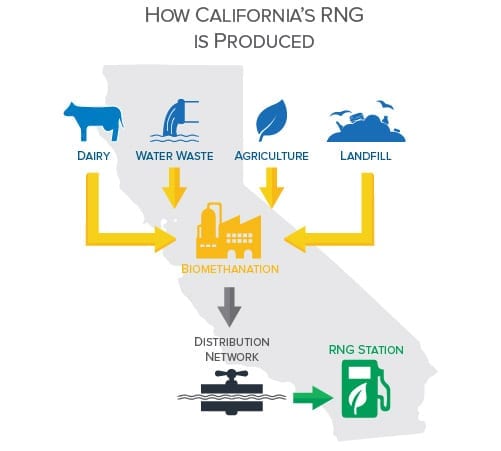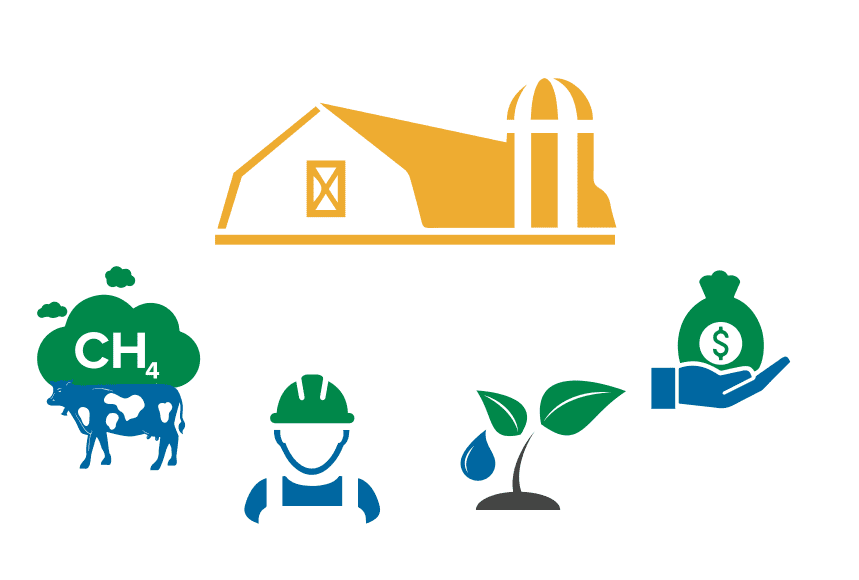Renewable natural gas is a cost-effective fuel that can be used as a 100% substitute for, or blended with, conventional natural gas.
Renewable natural gas (RNG) is made from 100% renewable sources.
RNG is made primarily from organic waste, generated by a variety of sustainable and renewable sources, including wastewater treatment plants, food and green waste, landfills, dairies, farms, and forest management. It can also be produced as a byproduct of renewable hydrogen and sequestered CO2, a key strategy to store surplus renewable electricity.
Unlike fossil fuel, RNG is not formed by a geologic process and did not spend millions of years underground. RNG simply recycles carbon that is already present in the biosphere and does not add carbon to the atmosphere.

Using RNG enables fleets to go beyond carbon neutrality.
All motor vehicle fuels have a “carbon intensity (CI)” value, which is the total amount of GHGs emitted from production, transportation, refining and consumption. A negative carbon intensity value means that the use of this fuel actually reduces global warming potential in the atmosphere. In 2023, the energy weighted carbon intensity value of all natural gas used for transportation fuel in California was below zero at negative 72.73 gCO2e/MJ, according to recently released data from the California Air Resources Board’s (CARB) Low Carbon Fuel Standard (LCFS) program.
Natural gas vehicles (NGVs) operating in California provide the greatest greenhouse gas (GHG) emission benefits compared to all other transportation fuels and should be a key component in the strategy to combat climate change.
Learn more about the benefits of producing and utilizing carbon negative fuel.

Using RNG enables fleets to save money.
To expedite adoption of low carbon fuels, California created a comprehensive, verified, state-wide system—the Low Carbon Fuel Standard (LCFS) program. Since first implemented in 2011, low carbon fuel use is increasing and fuel producers in California are continuing to take action to decrease carbon intensity.
According to CARB’s LCFS data, more than 98% of natural gas used for transportation in California already comes from renewable sources. Fleet operators fueling with RNG can further lower their fuel cost via the financial credits afforded under the federal RIN Program and California’s LCFS Program.

The U.S. can produce large volumes of RNG.
As long as we have a productive society, we have the ability to capture and reuse methane emissions from organic waste at dairies, farms, wastewater treatment plants, and landfills.
A 2019 ICF study found that by 2040 there will be up to 32 billion diesel gallons equivalent (DGE) of RNG supply available nationally. Total on-road diesel use currently falls at about 46 billion DGE annually, meaning RNG could replace nearly 70% of the US’ on-road diesel fuel use annually.
Supporting the continual increases in RNG volume, NGVAmerica’s 2021 On-Road RNG Use report noted that there are:
- 250 RNG production facilities in operation
- 112 RNG production facilities under construction
- 125 RNG production facilities in development

Sources:
- Getting to Neutral: Options for Negative Carbon Emissions in California, January 2020. https://www-gs.llnl.gov/content/assets/docs/energy/Getting_to_Neutral.pdf
- California Air Resources Board 2023 Low Carbon Fuel Standard Data
- American Gas Foundation, December 2019, Renewable Sources of Natural Gas: Supply & Emission Reduction Assessment Study. https://www.gasfoundation.org/wp-
- content/uploads/2019/12/AGA_3894-RNG-2-Pager_V-11.pdf









